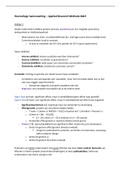Summary
Samenvatting Colleges - Applied Research Methods: D&H
- Course
- Institution
Dit is een samenvatting van mijn college-aantekeningen van Applied Research Methods: Development & Mental Health (SOW-PSB3RS45E, Radboud). Ik verkoop ook mijn uitgebreide aantekeningen en antwoorden op de study questions! Ik heb dit vak afgerond met een 9. Ik heb hiervoor alleen de stof uit ...
[Show more]



